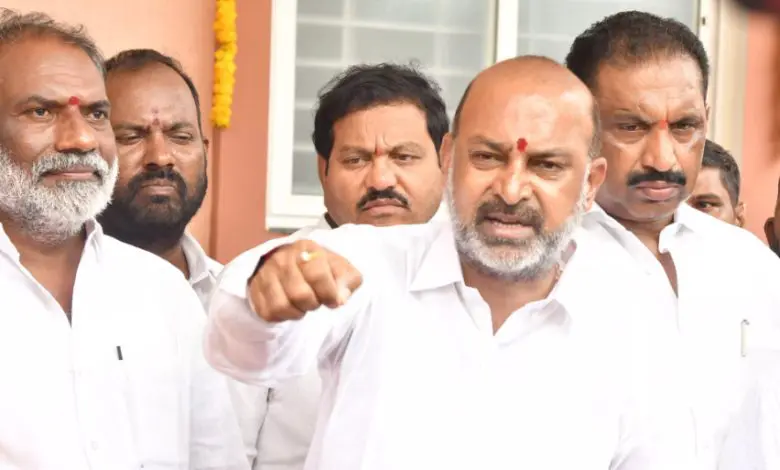Hyderabad, Union Minister of State for Home Affairs Bandi Sanjay accepted the challenge posed by BRS working president K.T. Rama Rao, stating that he could prove the allegations made against KTR by MP Ramesh. Sanjay Kumar challenged BRS working president K.T. Rama Rao to an open debate on the allegations leveled against him by BJP MP C.M. Ramesh from Unkapalli. Ramesh accused him of proposing a merger of BRS into BJP in 2023.
Speaking to journalists in Karimnagar on Sunday, Sanjay alleged that the BRS government is steeped in corruption. BRS leaders, unable to run their party, had come up with a merger proposal. However, he mentioned that during a public meeting in Nizamabad in 2023, Prime Minister Narendra Modi had made it clear that the BJP opposes family-centric parties and dynastic politics.
Also read…
Allegations against KTR and Congress’s appeasement policy
Bandi said that time and place should be decided by KTR. He stated that he would organize a public debate in Karimnagar or Hyderabad to prove Ramesh’s allegations against Rama Rao. BRS is on the verge of extinction, and its leadership is incapable of running the party. He accused Rama Rao of spreading false propaganda against the BJP through social media platforms, warning that such lies would no longer be tolerated. He also alleged that Congress leaders in Telangana are not responding to KTR’s derogatory language against their own leaders.
Accusing the ruling Congress of practicing appeasement politics, he demanded that Muslims be excluded from the backward classes list and that 42% reservation be exclusively allocated to backward classes. Earlier, the Union Minister inaugurated a Critical Care Block constructed with central funds at the Government General Hospital in Karimnagar, estimated to cost ₹23.75 crore.
Hyderabad
Hyderabad is a historic city in southern India, founded in 1591 by Muhammad Quli Qutb Shah as the capital of the Golconda Sultanate. Known for its rich cultural heritage, it is home to iconic landmarks like the Charminar, a 16th-century mosque and monument, and the Golconda Fort, a former diamond-trading center. Today, Hyderabad is a major tech hub, often called “Cyberabad,” while preserving its blend of Mughal and Telugu traditions.
Karimnagar
Karimnagar is a historic city in the Indian state of Telangana, known for its rich cultural heritage and ancient landmarks. It was once a prominent seat of power under the Satavahanas, Kakatiyas, and later the Nizams, with notable sites like the Elgandal Fort and the Kondagattu Anjaneya Temple reflecting its historical significance. Today, it serves as an important commercial and educational hub in the region.
Unkapalli
Unkapalli is a small village in the Indian state of Andhra Pradesh, known for its historical and religious significance. It is home to the ancient *Sri Kshira Rama Lingeswara Swamy Temple*, dedicated to Lord Shiva, which dates back to the 9th-10th century during the Eastern Chalukya dynasty. The temple is renowned for its unique feature of a Shiva lingam that is said to ooze milk (*kshira*), attracting pilgrims and visitors.
Nizamabad
Nizamabad, located in the Indian state of Telangana, is a historic city known for its cultural heritage and agricultural significance. Founded during the reign of the Rashtrakuta dynasty, it later became a prominent region under the Nizams of Hyderabad. Key attractions include the Nizamabad Fort, built in the 10th century, and the nearby Pocharam Wildlife Sanctuary, adding to its historical and natural appeal.
Government General Hospital
The Government General Hospital, often established during colonial periods in various regions, served as a key medical institution under colonial administrations. For example, in Taiwan under Japanese rule (1895–1945), the Government General Hospital in Taipei (now part of Taipei City Hospital) was a leading healthcare facility, reflecting colonial-era medical advancements. Similar hospitals in other regions, like India under British rule, were central to public health systems but also symbolized colonial authority. Many have since been repurposed or integrated into modern healthcare networks.






